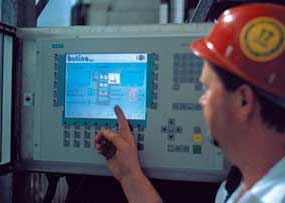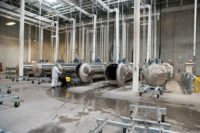Plant Profile: Fast-Track Expansion


Lundy's has been packing and processing hogs in eastern North Carolina since 1950. Piecemeal expansion and irregular capital reinvestment resulted in a plant that was high volume but in need of improvements when Premium Standard bought it two years ago. Rather than simply bring the plant up to contemporary safety and sanitation standards, the goal of the $38 million project was to raise the bar.
"Strategically, having a packing house on the East Coast is a huge advantage in terms of customer service," observes Jere T. Null, who took over as the plant's general manager after the sale. "But not a lot of money had been spent here in the 10 years before the acquisition, and the equipment had some age in it. Premium Standard bought the plant with the idea of expanding production and enhancing productivity, sanitation and employee welfare."
Within six months of the plant purchase and Null's arrival, the 114,000 sq.-ft. expansion project commenced. Engineers from Jacksonville, Fla.-based the Stellar Group handled design/build duties and worked around ongoing production.
The project focused on three areas: refrigeration system improvements, a new cut floor and humane slaughter processes that have opened new markets for Lundy's because of the product-quality improvements they make possible.
Major restaurant and supermarket chains are pressuring packinghouses to institute humane animal-handling practices, backing up the demands with independent audits. The pressure is prompting meat processors to take a closer look at carbon dioxide as an alternative to electrical stunning. CO2 stunning has become the norm in Europe, and Lundy's is in the first wave of U.S. plants to adopt it.
Fran Leerkes (left) and Jere Null review performance reports for Lundy’s recently expanded plant. Both men joined the 52-year-old pork processor after its August 2000 purchase by Premium Standard Farms Co. CO2 stunning is a misnomer, points out Fran Leerkes, Lundy's engineering & maintenance manager. Gilts and barrows are anesthetized, emerging in an unconscious state. There is no squealing or thrashing as they are shackled and slaughtered.
In contrast, violent convulsions often accompany electrical stunning, resulting in ruptured blood vessels and considerable stress in the staging area. Internal bleeding produces blood splash, the industry term for discolored meat that is regarded as inferior quality. "Until we went with CO2 , Japanese buyers wouldn't even consider us as a source," Leerkes says. With CO2 and improved processing and packaging techniques, Lundy's has been able to crack the premium segment of Japan's fresh chilled market.

Procurement Manager Mike Cavanaugh checks the control panel for one of the Butina CO2 stunning units. Valves are automatically opened to replenish the gas supply when it dips below the set point.
"We can run about 75 percent of our line speed with one CO2 unit," says Leerkes. With both running, the units easily handle 1,000 head an hour.
Because carbon dioxide is denser than the atmosphere, the gas remains below grade, except for trace amounts that remain in the animals' lungs. Gas replenishment, additional utility costs and a slight labor penalty add "a few pennies per head" compared to electrical stunning, Null estimates, "but the benefits greatly outweigh the costs. We wouldn't have done it if the economies weren't there."

Precision cutting
Better-quality carcasses may have opened the door to the Japanese market, but the plant also needed better packaging and processing equipment to tap that potential. A new 44,000-sq.-ft. cut room and adjoining packaging area tripled the work area compared to the old cut floor. Cryovac vacuum bags replaced waxed polybags and extend the refrigerated shelf life of fresh pork to 45 days, giving Japanese resellers two to three weeks to sell the meat.A 19,300-sq.-ft. mezzanine rings the cut floor. Vacuum pumps for the packaging machines and box-making equipment are housed there. Die-cut boxes assembled by machine represent a significant cost savings compared to hand-made boxes.
Knife scores and other imperfections are cause for rejection of Japan-bound cuts. Jamie Axthelm was brought in from Premium Standards' Milan, Mo., plant to oversee quality assurance. Training line workers to meet Japanese specs has helped raise quality levels for all products. "What's good for Japan ultimately helps everyone who does business with us," Null points out.
Boning and cutting tables are elevated several feet above the floor, a design that facilitates sanitary cleanup. The equipment was designed and built by G.E. Leblanc Inc., specialists in hog cutting systems. Notable features include a clean-in-place system and an automatic scribing and loin-pulling machine. Those systems, along with variable frequency drives on the belts and automatic sortation units, are controlled by 10 PLCs in the room, says Leerkes.
"We run a very consistent animal in terms of size, and that's what makes the automatic loin puller work," he adds, noting that cutting is much more consistent than in a manual operation. Carcass consistency certainly helps, agrees Patrick Fauret, president of Leblanc, but advances in automatic measurement technology is the real key to the state-of-the-art device. An innovative system of sensors defines carcass dimensions and control the cutting. "Everything is a question of millimeters and is very precise," says Fauret.
Sanitary design is making CIP the standard on cut floors, though Lundy's facilities benefit from being the latest in evolutionary improvements. Extensive engineering enables the Leblanc system to function without water at transfer points and chutes, eliminating a common source of cross-contamination. "Quite a lot of design and good engineering work was needed to overcome the challenge" of waterless conveying, Fauret says.
In fact, minimizing the presence of water, whether in liquid or vapor form, was a core engineering objective in the expansion project. "Maintaining a clean-room environment below 40¿ with a huge number of moisture sources requires a very high air-flow rate to avoid condensation," explains engineer Charles R. Taylor, senior vice president with the Stellar Group. Seven hygienic air makeup units mounted on the roof each generate 70,000 cubic feet of filtered and conditioned air per minute, creating positive pressure that draws out moisture before it has a chance to condense on walls and pipes. The units were placed on the roof to allow maintenance and repair activities to proceed without interrupting production.
Cooler expansion and an overhauled quick-chill room involved 37 ceiling-hung evaporators. Air moves through the quick-chill unit at 2,500 feet per minute, and existing fans were woefully inadequate to supply that velocity. To avoid interruptions to production, more powerful fans were installed during weekends, Taylor says, and extensive piping modifications were made.
By carefully balancing temperature, air velocity and dwell time, quick-chill operators create a crust on the surface of the carcass. Temperatures go from 98¿F to an equilibrated temperature of 36¿ in 135 minutes.
Subsequent cooler storage enables the carcass to reach a consistent temperature throughout. Properly executed, the process yields meat of superior color and texture.
Construction during production
Groundbreaking ceremonies for the expansion were held Feb. 28, 2001, and Null fully expected to begin using the new facilities the following January. Instead, production areas started coming on line in October. "I have never seen such a large-scale job completed with such few problems," he reports. "Stellar built around our production, and we never, ever had to stop," Null adds.Capacity on the kill and cut lines went from 830 heads to 1,000 an hour, a 20 percent improvement. Staffing increased, but so did efficiency. "We measure our hogs per man-hour when looking at productivity," says Null. "We went up about 10 percent."
Worker injury rates fell below the industry average last year, netting Lundy's the American Meat Institute's Golden Star Award, and the ergonomic design of the cutting tables and the automation of some tasks are expected to further reduce the number and severity of injuries.
The sprawling facility has about 600,000-sq.-ft. under roof. Fresh meat processing is the focal point, but the plant is involved in a wide array of activities, from rendering and natural casing manufacture to bacon and other prepared meats. A staff of 80 maintenance people with a wide range of skills is on hand to keep processes as diverse as lard and bacon-bits production going and enables Lundy's to expand into new areas, such as pet foods. Updating equipment in the processed meats areas will be the next order of business.
"Many of the plants built in the last 10 years have had very long learning curves in gaining a stable workforce," Null reflects. "We have a state-of-the-art facility now with a very stable workforce, and that is a potent advantage."
The 1,300 employees in Clinton, N.C., have the talent and skills needed to produce value-added products. Now they have to tools to do it, as well.
For more information:
Butina
011-45-594 50460
info@butina.dk
Yvon Dufour
G.E. Leblanc Inc.
418-885-4493,
Charles R. Taylor
The Stellar Group
904-260-2900
ctaylor@thestellargroup.com
Looking for a reprint of this article?
From high-res PDFs to custom plaques, order your copy today!



